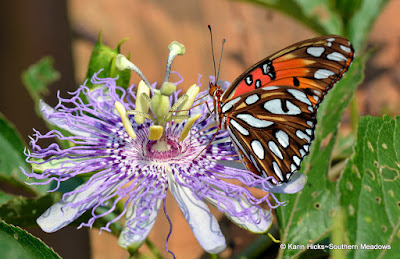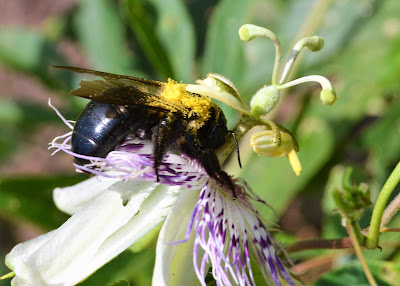Passiflora incarnata: A multifunctional native vine
Passiflora incarnata is a plant that may be called a wildflower, weed, edible fruit or medicinal herb. However you view it, this native makes a versatile plant for the garden. This tendril climbing vine grows rapidly in summer and produces showy, fringed flowers that will add flare to your landscape.
It grows in medium to well drained soil (too wet will cause root rot) in full to part sun. It spreads by root suckers that will cover large areas when it's happy.
What's in the Name
If you step on the fruit it 'may pop'. This distinct popping sound gives it the common name Maypop. The genus name, Passiflora, comes from the Latin passio meaning passion and flos meaning a flower.
The floral structure has deep religious symbolism. Early Christian missionaries used the flower as an educational tool to describe the passion of Christ. The three styles above the stigma represent the three nails by which Christ was attached to the cross. The five anthers over the stamens represent the hammers used to drive the nails or Christ's five wounds. The purple filaments depict the crown of thorns and the ten petals personify the ten apostles at the Crucifixion (save Peter and Judas). The species name, incarnata, means made of flesh or flesh colored. The lobed leaves and long green vines denote the hands and whips of Christ's prosecutors.
In the Garden
Passiflora incarnata is an excellent vine to grow up a trellis, pergola or fence. In our garden some vines even use our house as its trellis. But it doesn't need to climb to produce flowers. One can pinch the vine back to maintain a more shrub like appearance. This will need to be done regularly during the growing season, especially in peak summer months.
Another option is to allow it to grow up trees and over shrubs or dangle over a retaining wall. In our wildlife hedge row, we allow the passion vine to ramble through the landscape; growing on shrubbery, up trees and dangling over the retaining wall. The vines help to soften the hard lines of the wood wall that runs along the driveway and helps reduce the surface temperature. Passion vine also works well in naturalized areas or in meadows where it is allowed to spread.
 |
| Passiflora incarnata growing over retaining wall |
For the Pollinators
We first introduced Passiflora incarnata to our garden to support pollinators. This native host plant is munched on by gulf and variegated fritillary caterpillars. This time of year various instars strip the vines bare in a hurry. |
| gulf fritillary caterpillar |
The vine has a long flowering season and is pollinated by native carpenter and bumble bees, butterflies and the occasional hummingbird.
 |
| gulf fritillary butterfly |
Carpenter bees in particular find the exotic looking blooms irresistible. They spend daylight hours buzzing from one bloom to another; sometimes, taking a nap on the flowers.
 |
| look at all the pollen collected on the carpenter bee! |
An incredible edible
Once pollinated they form a fruit the size of an egg. Did you know that this fruit is edible?
Typically we think of the tropical passion fruit (Passiflora edulis), but Passiflora incarnata, a North American native is also edible. The fruit usually develops summer through fall and is a delicious treat.
 |
The fruit is ripe when it feels heavy. It usually falls off the vine when it is perfectly ripe. Eat as soon as it is harvested as the fruit becomes lighter and wrinkles as it ages. The pulp and juices dry up and eventually the seed pod will open to disperse seeds.
The sweet fruity pulp (white to yellow in color) can be scooped directly from fresh, ripened fruits. You may choose to eat the crunchy seeds or spit them out. It has a tart flavor similar to a lemon but not as pungent. Do not eat over ripe fruit because the taste will go from refreshing goodness to unpleasant nastiness.
Another option is to strain the juices with a cheese cloth or strainer that will capture the pulp and seeds. Use the liquid to make a drink. If you like it sweeter try adding some orange juice but if you like tart add some lemon or lime juice to give it a kick. Jellies and syrups can also be made if you have a big fruit harvest.
According to the USDA/NRCS plant guide, the Cherokee Native American tribes used passion flower for food, drink and medicinal purposes. They grew this vine in their corn, squash and bean patches allowing this weedy edible to fill in the bare patches. The fruits were eaten raw or boiled to make a syrup. The young shoots and leaves were eaten with other greens.
Medicinal
Medicinally, passion vine was used by Native American people to treat a variety of issues. The roots were used as a poultice to draw out inflammation from thorn wounds, a tea given to babies to aid in weaning, and as eardrops to treat earaches.
Whereas ethnobotanical literature describes the primary use of roots, today the leaves and flowers are primarily used for medicinal purposes. Studies show that the chemicals in passion vine have calming, sleep inducing effects. It is used to treat anxiety, insomnia or stress. It is thought to increase gamma-Aminobutyric acid (GABA), your brain's main inhibitory neurotransmitter. GABA is also believed to regulate the production of the melatonin hormone, which aids in the sleep-wake cycle. The leaves, flowers and vines can be used to make a tincture or tea.
This is a very worthy native vine to include in your pollinator, meadow, edible or medicinal gardens. Regardless of how you use this plant, the flowers are a spectacle everyone will appreciate.








.png)
